Blog
Do tadpoles make sounds?
Posted by scahalan on March 16, 2015
Applying acoustic ecology to private land conservation
By James Hattam
While it might not be the burning ecological question of our time, it is a question few can answer. And as an ecologist I had no idea when I was asked. 'So, do tadpoles make sounds?'.
The answer is YES.
While the repetitive chorus of male frogs calling in the hope of attracting a mate is a common occurrence when we visit wetlands or other aquatic habitats, the unique vocalisations of tadpoles are something that is foreign to even the most avid nature enthusiast.
With the help of technology, we at the Protected Areas on Private Land Program, a partnership between the Tasmanian Land Conservancy and the Tasmanian State Government, are taking conservation landholders on a journey of discovery and opening their eyes and ears to the world of bioacoustics.
The field of bioacoustics or acoustic ecology is an emerging, cross-disciplinary science that brings together biology, ecology and acoustics. As conservation professionals we typically make conscious visual observations to guide and inform our understanding of ecological processes and ecosystems. We often use our ears subconsciously to listen to natural systems, yet rarely link what we learn formally.
Acoustic ecology provides that link. Bernie Krause, the famous American composer, is often referred to the god father of bioacoustics and soundscapes, and explains the emergence of the field through his life work in an inspiring TED talk.
During a recent visit to covenanted property is southern Tasmania, I along with conservation landholders Lyne and Allesandro, thought we would have a listen to one of their natural wetlands. You may ask how do you listen to a wetland? No, it doesn't involve getting wet. The answer is with the help of a hydrophone, which is a simple microphone designed to be used underwater for recording or listening to underwater sound. By setting up a hydrophone through a digital recorded we can listen live to what is going on in the aquatic environment.
It is fair to say when we put the head phones on to listen we were blown away. While it was silent above the water, it was a buzz with activity beneath the surface. Listen for yourself. And after some thorough searching we were able to decipher that the sounds we were hearing were tadpoles. This was first discovered by a team of scientists in Argentina in 2010.
This technology provides us with an incredibly powerful tool, whereby we can listen, record and share the unique sounds of ecosystems which we are naturally removed from. The soundscape can comprise a plethora of origins, from microscopic invertebrates feeding on detritus to the complexity of a dawn chorus of woodland birds. These sounds are often unique to an environment, which make them a useful means in monitoring changes in these systems through time as well as engaging the broader community through sharing these unique and often bizarre sounds to appreciate the value of protected areas on private land and the array of ecosystems and biodiversity which rely on them.
Below, Lyne and Allesandro listen to the life aquatic in a wetland on their property.
Photo: James Hattam
Conservation properties for sale
Posted by scahalan on December 10, 2014
Media release
9 December 2014
Land for sale offers lifestyle and conservation satisfaction
The Tasmanian Land Conservancy (TLC) is offering outstanding blocks of land for sale across Tasmania over the summer months.
The blocks have conservation covenants placed over high-priority forest communities, resulting in the protection of habitat for threatened or rare flora and fauna. Some are offered with sites available for residential development.
"These properties offer the best of both worlds — the opportunity to own a beautiful retreat, and own a private reserve," said property manager Jim Mulcahy.
"Buying a property with protected vegetation is an excellent way to protect your local community of Tasmanian devils or wedge-tailed eagles," Mr Mulcahy said.
The blocks are for sale as part of the Tasmanian Land Conservancy’s Revolving Fund. Proceeds from the sale of the properties are returned to the Revolving Fund, which is then used to help protect threatened communities on private land.
Some of the properties available for sale include:
Derwent Valley
Bullock Hills: Five blocks at Hollow Tree, 20 km north of New Norfolk, range from 20 to 137 ha. Each block features good road access, sunny house sites and attractive rural and bush land views. One block has sold, with five remaining on the market. $69,000-$125,000
East Coast
Lilla Villa: Just six km south of Bicheno, this 95 hectare property provides easy access to spectacular beaches, National Parks and essential services. With a long frontage onto the largest pool in the Apsley River and an existing internal track network, it offers excellent recreational opportunities, such as swimming, bushwalking and fishing. All of this in a private and peaceful bushland setting with several potential home sites close to the river. $165,000
North-east Coast
Shiny Grasstree: on the corner of Greens Beach Road and Badger Head Road, Clarence Point is approximately 41 hectares with a cleared house site and driveway. It is just ten minutes from Greens Beach, Badger Head and a Tamar River boat ramp. The purchaser of this property will be making a major contribution to the conservation of endangered black gum and heathy coastal black peppermint forest, as well as acquiring a superlative bush retreat close to the coast. $149,000
The Revolving Fund runs in partnership with the Tasmanian Government and is supported by the Australian Government.
Visit the Revolving Fund page to view all properties for sale.
The Tasmanian Land Conservancy is a science-based, non-government organisation that purchases and manages land for biodiversity. We currently have thirteen permanent reserves and thirteen Revolving Fund properties.
More information or to request images: Stephenie Cahalan 0417 699 917
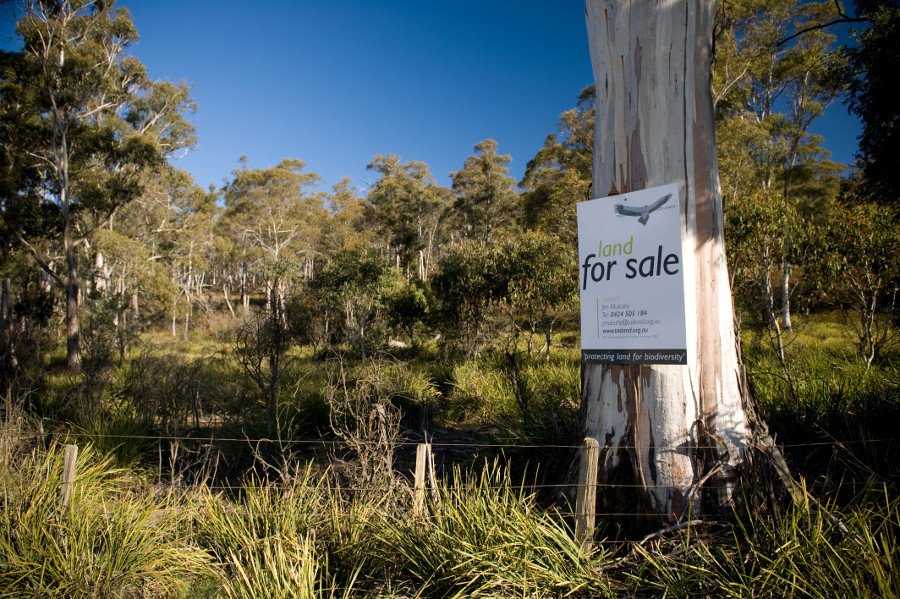
Bullock Hills property for sale at Hollow Tree in the Derwent Valley. Photographer: Matthew Newton
Conservation's next generation
Posted by scahalan on December 3, 2014
A global perspective of generational challenges in conservation
By James Hattam
Crossing the Parramatta River on Silverwater Road in the midst of peak hour traffic may seem like an obscure place to learn of the inspirational raise of Yolanda Kakabadse from founding a fledgling and bare-bones environmental NGO in the Republic of Ecuador to become the current President of World Wide Fund for Nature - International (WWF). As part of the IUCN World Parks Congress in Sydney last month, this is where I found myself.
I was privileged to participate in WWF's Next Generation event and spend a day with a group of emerging young conservationists from all corners of the globe. We joined with Yolanda Kakabadse in Lane Cove National Park (NP) to share stories and discuss the global conservation challenges we all face in our own communities. Journeying from Sydney Olympic Park to Lane Cove NP, Yolanda shared anecdotes and enlightening experiences of her career to date, from Minister of Environment in the Republic of Ecuador to president of the International Union for Conservation of Nature (IUCN). Yolanda, a trained psychologist and self-confessed non-biological scientist, has dedicated her endeavours to promote the benefits of conservation, the involvement of civil society and advocate for sustainable development in her home of Latin America and across the world.
After stepping off the bus at Lane Cove NP my instincts kicked in and I immediately searched for patches of shade to shelter from the intense sunshine; it is fair to say that as a well acclimatised southerner I was struggling with a 40 degree Sydney day in November! At one point as we followed the undulating walking trail I'm convinced I spotted a magpie panting in an attempt to get some respite from the heat, or perhaps the magpie was laughing at the struggling Tasmanian.
Walking through the eucalypt forest and woodlands provided the ideal backdrop to share stories and learn of the great work others from around the world are part of. From Marine Protected Areas in Madagascar to community managed reserves in India, the immense passion and dedication of these young professionals was clear as soon as each person began to speak. Over lunch on the banks of the Lane Cove River, Yolanda led a discussion on the global challenges for conservation and the opportunities for the next generation.
The overwhelming theme from each contribution was the need to have meaningful community participation which appeals to people's social and cultural identity, and fosters an on-going connection with the benefits of the natural environment. The need to effectively communicate with the civil society also resonated through many stories. In an age of innovation and technology, we as conservation professionals need to utilise technology to engage and inspire across generations to appreciate the benefits of conservation and connect with the natural world. Without community ownership of protected areas, conservation efforts are doomed to fail.
That afternoon I left Lane Cove NP with a sense of hope and resolve to take the stories I heard from around the world that day back to my work on the Protected Areas on Private Land Program, to ensure the benefits of private land conservation efforts across Tasmania and the communities that drive it are appreciated.
In a time of drastic change across the planet, where communities are more frequently becoming detached from their environments, the plight of the natural world can become overwhelming. The need for us to effectively engage and meaningfully involve local communities in conservation efforts is an imperative to ensure conservation stays relevant in our society. The next generation's youthful enthusiasm and passion for the natural environment is something to be fostered. Through these traits, coupled with the sharing of knowledge and wealth of experience from older generations, key lessons can be learned and the movement for change encouraged.
In his watershed opening address at the last IUNC World Parks Congress in Durban 2004, the late Nelson Mandela, champion of empowering the world's youth in addressing global challenges, provided some advice in true Mandela fashion:
"You may very well be a little curious to hear what an old man without a job, office, power or influence, and with his roots far in the past, is going to say about challenges for the future! The future is after all, in the hands of the youth."
Listen to Nelson Mandela's opening address to the IUNC 2004 World Parks Congress in Durban 2004.
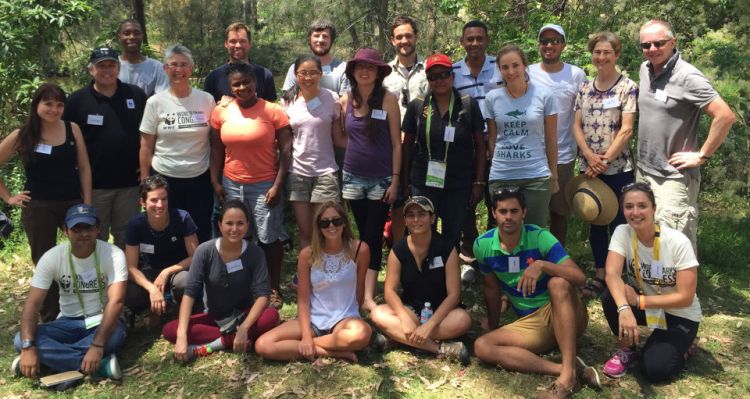
James Hattam (rear back in the centre) enjoys the company of the next generation of conservation leaders at Land Cove National Park. Yolanda Kakabadse, President of WWF-International, is third from the left in the middle row, and Rob Purves, TLC supporter and President of WWF-Australia stands on the far right.
Open Standards University course for Asia-Pacific/Oceania region
Posted by scahalan on November 18, 2014
The World Commission on Protected Areas has identified a need in the Asia and Oceania Regions for capacity building to equip protected area practitioners with the necessary knowledge, skills and competencies for effective management of protected area systems on land and sea. A collaboration of protected area practitioners from universities, government, private protected areas and conservation organisations has been established to meet this need.
Courses offered specifically address competency standards identified by Global Partnership for Professionalising Protected Area Management (GPPPAM). It is anticipated that these courses will be amongst the first in the world accredited under GPPPAM.
The first course forms part of Graduate Certificate of Protected Area Planning: KGA531 Protected Area Management Plans will be run in Tasmania, Australia.
This five day intensive course will equip you with the understanding and ability to use an internationally recognised, integrated conservation planning and management framework - the Open Standards for the Practice of Conservation. The live-in course will feature the Tasmanian Land Conservancy’s stunning Five Rivers Reserve in the heart of Tasmania as the case study.
It will run from Monday 2nd - Friday 6th February 2015 at Bronte Park, Tasmania, adjacent to the TLC’s Five Rivers Reserve, 2.5 hrs bus drive from Hobart. The costs, which includes all food, accommodation, transport, materials, is AUD 1,900
To register or for further information, please contact Stuart Cowell +61 427 508 308 ([email protected]) or Daniel Sprod +61 428 240 007 ([email protected])
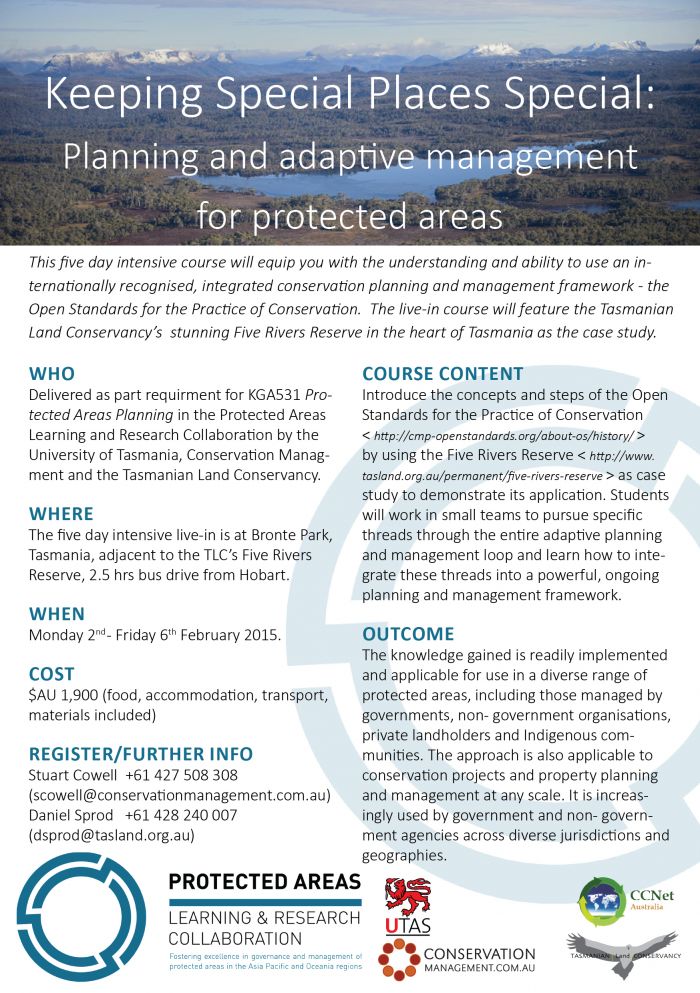
Banksia Award win for the Tasmanian Midlands
Posted by scahalan on November 11, 2014
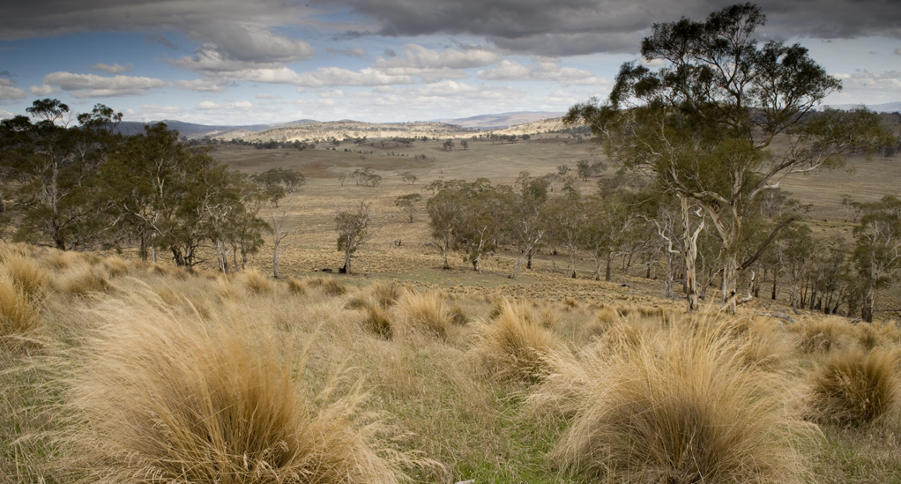
Media release
Tasmanian Land Conservancy and Bush Heritage Australia have won a prestigious Banksia Award for their work with farmers in helping to conserve the Tasmanian Midlands.
The Midlands Conservation Fund has scooped the prize in the Natural Capital section of the 2014 Banksia Foundation Sustainability Awards, recognising demonstrated leadership and innovation in the sustainable management of renewable and non-renewable resources.
The fund is a partnership between Bush Heritage Australia, the Tasmanian Land Conservancy and the farmers who safeguard the remnant native grasslands and grassy woodlands on their properties. The project was launched in 2013 with a landmark $3.3 million conservation fund supported by philanthropic individuals and government.
'This award is recognition that we’re doing it right. Our stewardship agreement model has been successful because it is underpinned by a fund that can provide money for conservation in perpetuity,' says Andy Myer, MCF Chairman and Bush Heritage Australia vice-president.
'Temperate grasslands are the world’s most endangered ecosystem,' said Gerard O’Neill, Chief Executive of Bush Heritage Australia.
'In order to protect those last pieces of remnant native grasslands and grassy woodlands, lasting conservation outcomes need to be balanced alongside livelihoods, and this has delivered on both fronts,' he said.
The program helps to conserve biodiversity on farms in the Tasmanian Midlands by offering stewardship agreements to farmers, paying for long-term conservation management on their land.
Ten farmers have signed up to the programme and so far 2,636 hectares of grasslands and woodlands have been protected through the scheme.
'This is one of regional Australia’s great success stories,' said Jane Hutchinson, CEO of the Tasmanian Land Conservancy.
'This Banksia Sustainability Award confirms for farmers that the coexistence of critical conservation work and productive farming is valued,' said Ms Hutchinson.
The Tasmanian Midlands, one of Australia’s 15 biodiversity hotspots, are home to 32 nationally threatened species and more than 180 plants and animals threatened at state level, it provides habitat for species that are extinct or close to extinction on the mainland, such as the Tasmanian devil, eastern bettong, spotted-tail quoll and eastern barred bandicoot.
The fund will have the capacity to support many more landowners to conserve habitat on working farms and seeks to reach $10 million by 30 June 2020 to cover a further 8000 hectares of grasslands and grassy woodlands in the Tasmanian Midlands.
TLC shares reserve management expertise at environment conference
Posted by scahalan on October 30, 2014
The Environment Institute of Australia and New Zealand conference has taken place in Hobart this week with Daniel Sprod, TLC's landscape ecologist, presenting two papers on private land conservation in Tasmania.
Practical conservation at the landscape scale: Midlandscapes is co-authored by Daniel Sprod and Andrew Cameron from the TLC; Sebastian Burgess and Neil Davidson from Greening Australia; and Bush Heritage Australia's Matt Appleby. The paper outlines the success of the Midlandscapes program as an enduring approach to cooperative biodiversity management within a predominantly private farming context in Tasmania.
Midlandscapes, recently nominated for a Banksia Environment Award and a Tasmanian Community Award, is a partnership between organisations involved in conservation, restoration and natural resource management.
The program protects native vegetation remnants with high natural value, establishes management regimes to facilitate survival of native flora and fauna in a changing climate, and enhances the natural value of degraded vegetation by strategically planting local native species to buffer and connect existing healthy native vegetation remnants.
The second paper, Multiple benefit conservation in Tasmania by Daniel Sprod and Jane Hutchinson, explores the Five Rivers Conservation Project.
This is an innovative global partnership between the Tasmanian Land Conservancy, Conservation International and BHP Billiton which has facilitated the conservation and ongoing management of over 11,000 hectares of land in the Tasmania’s Central Highlands.
Both papers were enormously well received, highlighting the growing importance of sharing knowledge gained through private land conservation projects and partnerships.
Midlands Conservation Fund short-listed for two awards
Posted by scahalan on October 21, 2014
The Midlands Conservation Fund has been shortlisted for a prestigious 2014 Banksia Sustainability Awards and the Tasmanian Community Achievement Award.
The Midlands Conservation Fund is a partnership between the Tasmanian Land Conservancy and the Bush Heritage Australia. The program helps farmers safeguard remnant native grasslands and grassy woodlands on their own properties.
“The Midlands Conservation Fund program was designed by farmers for farmers. Midlands landowners are achieving fantastic conservation outcomes on their own working properties” Jane Hutchinson, CEO of the Tasmanian Land Conservancy said.
The program helps to conserve biodiversity on farms in the Tasmanian Midlands by offering stewardship agreements to farmers, paying for long-term conservation management on their land.
“The Midlands Conservation Fund gets conservation on the farm balance sheet and recognises good management,” said Philippa Walsh, Bush Heritage’s Executive Manager of Conservation. “By working with farmers we are building on long-term local knowledge and expertise to protect native grasslands – one of the world’s most endangered ecosystems.”
The Tasmanian Midlands are home to 32 nationally threatened species and more than 180 plants and animals threatened at state level.
The winners of the Banksia Sustainability Awards will be announced in Sydney on November 11, and Tasmanian Community Achievement Award winners will be announced on November 21.
Skullbone Experiment in Sydney
Posted by scahalan on August 4, 2014
The Skullbone Experiment is the Tasmanian Land Conservancy's collaboration between art and nature. Following a four-day retreat on the Skullbone Plains in 2012, the eleven participating artists spent the ensuing year developing works of art inspired by their experience.
The variation in the work that was produced is as vast as the landscape itself; paintings, sculpture, photography, pen and ink, and multimedia. The diversity of the artistic impressions are a tribute to the gloriously different responses that nature invokes.
Coinciding with the hugely successful opening at UNSW Galleries in Sydney on July 18, ABC 7.30 ran story about the retreat, the exhibition and the Skullbone Plains.
The ABC 7.30 story and the extended version of the story that appeared on The Mix on News 24 can be viewed here.
The Skullbone Experiment will show at UNSW Galleries, Paddington until 30 August.
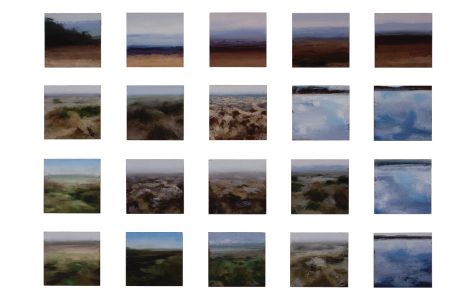
Skullbone Inventions, 2013 by Philip Wolfhagen
oil and beeswax on plywood 30 x 31.5 cm (each), 20 panels
Recherche Bay celebrated in oils by painter Ian Hansen
Posted by scahalan on March 2, 2014
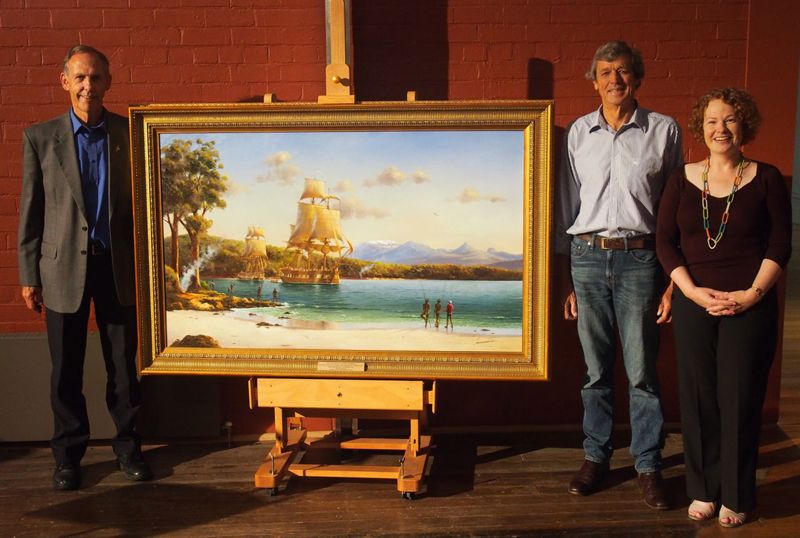 Photo: Dr Bob Brown, with artist Ian Hansen presenting the painting to Jennifer Storer of TMAG.
Photo: Dr Bob Brown, with artist Ian Hansen presenting the painting to Jennifer Storer of TMAG.
The Tasmanian Land Conservancy congratulates the Tasmanian Museum and Art Gallery (TMAG) on a recent addition to its’ collection; a large oil painting by celebrated Sydney marine artist Ian Hansen. The painting depicts the Lyluequonny People farewelling d’Entrecasteaux’s tall ships, the Recherche and Esperance, upon their departure from Recherche Bay in 1793.
The magnificent painting was commissioned and generously gifted to TMAG by Dr Bob Brown through The Bob Brown Foundation. The painting not only illuminates an historic and peaceful encounter between two peoples but highlights the importance of preserving a place of immense cultural and environmental significance such as Recherche Bay.
The Tasmanian Land Conservancy’s spectacular 142 hectare Recherche Bay permanent reserve was protected in 2006 with the assistance of Dr Bob Brown, Dick and Pip Smith and generous community support. Historic remnants of d’Entrecasteaux’s encampment are located within the permanent reserve. The reserve also provides habitat for the critically endangered swamp eyebright as well as several threatened bird species including white-bellied sea eagles, grey goshawks and swift parrots.
The Skullbone Experiment exhibition opening
Posted by on February 3, 2014

The TLC is proud to present The Skullbone Experiment, an art exhibition developed to raise awareness of the long term protection of biodiversity in Tasmania.
In February 2013, eleven high profile Australian artists were invited by the TLC to explore the wild and remote landscape of the TLC’s Skullbone Plains reserve on an artists retreat. Over four days, they immersed themselves in the landscape and were given scientific interpretation by TLC staff to deepen their experience on the reserve. An exhibition featuring works developed by the artists in response to their time at Skullbone Plains will open in Launceston in March 2014.
Permanently protected by the TLC in 2010 with the very generous assistance of our many supporters, Skullbone Plains shares a 16 kilometre boundary with the Tasmanian Wilderness World Heritage Area. It covers 1,600 hectares and provides habitat for critically endangered species such as the Clarence galaxias fish and an endangered plant community named sphagnum moss. The endangered Tasmanian devil, spotted-tailed quoll and wedge-tailed eagle also call it home.
Participating artists include Tim Burns (TAS), Joel Crosswell (TAS), Julie Gough (TAS), Philip Hunter (VIC), Janet Laurence (NSW), Vera Moller (VIC), Imants Tillers (NSW), Megan Walch (TAS), Richard Wastell (TAS), Philip Wolfhagen (TAS) and John Wolseley (VIC).
Jane Hutchinson, Chief Executive Officer of the TLC, said that it has been an absolute honour to have artists of such vision and calibre interpret Skullbone Plains permanent reserve.
"Their engagement with this landscape has been a great way to foster the link between art and the natural world” she said.
Renowned Tasmanian landscape painter Philip Wolfhagen is curating the exhibition with his wife, Catherine.
The exhibition is presented in partnership with the Queen Victoria Museum and Art Gallery and UNSW Galleries. It will be shown at:
Queen Victoria Museum and Art Gallery (QVMAG) Museum, Inveresk, Tasmania from the 15 March - 18 May 2014
Galleries UNSW, Sydney from 19 July – 30 August 2014
The TLC gratefully acknowledge the very generous support of the Purves Environmental Fund and the Purryburry Trust.
Pine Tier fire puts TLC’s Fire Action Plan into practice
Posted by on January 21, 2014
TLC Reserves Officer, Tim Devereux, waiting for Tasmania Fire Service to arrive at Pine Tier.
“Fire at Pine Tier. Call me...” was the alert left for us by Brady’s Lake Fire Brigade Chief David Hean early last Wednesday morning. The TLC’s Reserve Management Team quickly and efficiently put our Fire Action Plan into practice; supporting the Tasmania Fire Service (TFS) efforts, who are the responsible party in fighting fires on private land, including TLC’s conservation reserves.
Pine Tier is an area in the southeast of our 11,000 hectare Five Rivers Project Area, which is a few kilometres to the northwest of the town of Bronte Park in Tasmania’s Central Highlands. With hot and windy weather being forecast for the day, the fire had the potential to threaten the town by spreading rapidly and so containing and controlling the fire was imperative.
Reserves Officer, Bruce Hay, attempting to control the fire at Pine Tier.
The combined effort was a blur of activity to strategically coordinate fire trucks, helicopters, bulldozers and people to battle the fire. Two-way radios stuttered in the background delivering directives, while helicopters lingered overhead offering the reassurance of 400L of water instantly in critical areas. The wind would die down at times with fire settling into a trickle and the only noise would be the quiet chatter of the on-ground team and occasional laughter of the firefighters, waiting for the flames to leap up again with the next weather turn.
The fire eventually covered 370 hectares but did not spread beyond the TLC’s land. Six TLC staff trained in fire suppression worked alongside firefighters from the TFS and Parks and Wildlife Service (PWS). Their purpose was to both actively control the fire and to provide detailed knowledge of the property to support planning efforts. Our staff will continue to patrol the edges of the fire over the next week to ensure that any smouldering embers do not escape into unburnt bush and reignite the fire.
Backburning a containment line at Pine Tier.
Volunteer firefighters from at least nine different brigades assisted over the five days that the fire was burning and we are extremely thankful to these people, along with the professional firefighters from TFS and PWS.
Images captured by Denna Kingdom
Wedge-tailed eagles are breeding at TLC’s Five Rivers Conservation Area
Posted by on January 6, 2014

A wedge-tailed eagle chick sighted at TLC's Five Rivers Conservation Area.
You’re looking at just one of the fluffy faces that have put all trips to our Central Highland properties on hold for the summer… and we could not be happier!
At our annual eagle nest checks across TLC properties, Reserves Management Officer Shane McHugh spotted the newborn wedge-tailed eagle pictured above on our road to Skullbone Plains Reserve.
This means that we have very limited access to Skullbone Plains with visitation restricted to essential staff trips via a Forestry Tasmania road. In addition to our new celebrity pictured in the top photo, at least two more eagle nests have been found to contain recently born chicks, with another nest showing signs of nest lining and activity in November 2013. This is a great result for wedge-tailed eagles and hopefully indicates that our management of the properties is helping to conserve this much admired species.
Even though our Skullbone Plains Reserve and Central Highlands properties are off the cards this summer, everyone is welcome to visit our other reserves! Anyone wishing to schedule a visit this summer should contact Leigh Walters on 0407 891 025 or by emailing [email protected]
Celebrating a 'peace field' at Recherche Bay Reserve
Posted by on December 16, 2013
Beautiful Recherche Bay Reserve, in south-west Tasmania, came to prominence only in the last decade, but its significance for Australians goes back more than two centuries. It was there in 1791–1793 that many of Australia’s unique plants were collected by botanists for the first time and the concept of a 'peace field' was celebrated.
To document both the significance of this special place and mark its acquisition for conservation by the Tasmanian Land Conservancy, we interviewed specialists to take us on the historic journey of Recherche Bay’s past.
This taping was made possible thanks to the generous support of the Australian Garden History Society.
----
00.19 – Dr Andrew Cole (astronomer, University of Tasmania) describes the sites of the Recherche and Esperance observatories and what observations they may have recorded.
01.52 – Annick Thomas (local French historian) talks about the discovery of Recherche Bay and the first friendly meeting between the French and Tasmanian Aborigines.
03.24 – Dr Keith Corbett (geologist) discusses the prevalence of fossilised trees preserved at Recherche Bay, which are over 200 million years old and from before the time of flowering plants. They are one of the best, if not the best, examples of fossil wood in Tasmania.
06.27 – Sib Corbett (botanist) goes over the flora makeup that characterises Recherche Bay and notes that all the plants that French botanist, Jacques Labillardière, surveyed and named still exist there.
11.38 – Bob Brown (former leader of the Australian Greens) talks about the remarkable meeting (a peace field) and friendship between the French explorers and the Lyluequonny Aboriginal people who lived at Recherche Bay, along with an optimistic look at the future of the reserve.
A weekend of weeding at Liffey Reserve
Posted by on December 9, 2013
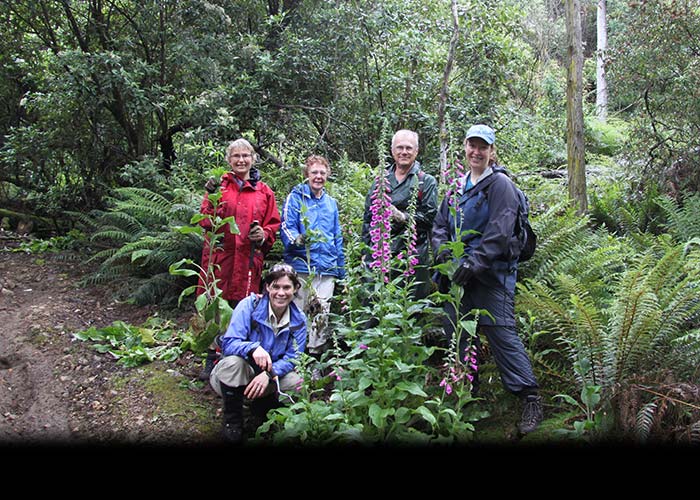
Some of our volunteers who helped with weeding at Liffey Reserve.
A team of nine enthusiastic volunteers spent the weekend of the 6-8 of December scouring the steep hillsides at Liffey Reserve for weeds, including foxglove and blackberries.
This is the second year in a row that this type of work has been done at Liffey Reserve, with a huge effort put in last year by a fabulous team of International Student Volunteers.
We were very pleased to discover that last year’s effort had made a huge impact on the quantity of weeds present at Liffey – there were very few foxglove around, and most of the ones that we did find were alongside roads or the river.
Our extensive weed search also found two old patches of elderberry trees, which are spread by birds eating the berries and depositing them as they fly. We’ll be researching the ecology of this weed species and will control the plants at a later date using the most efficient method possible.
While foxglove are a lovely plant in cottage gardens, they produce thousands of tiny seeds that spread very easily in water and soil and they have become an invasive environmental weed in Tasmania. So, if you live by the bush and have foxglove in your garden, please cut off the flower spikes before they start to set seed. As the old saying goes, one year of seeding is seven years of weeding.
We would like to thank everyone who donated their time to help with the upkeep of our beautiful reserve, as well as NRM North who generously sponsored the weekend.
If you’re interested in volunteering with the TLC register your details on our volunteer form.
TLC on the 7.30 Report - Taking custody of a slice of Tasmania's wilderness
Posted by on November 14, 2013
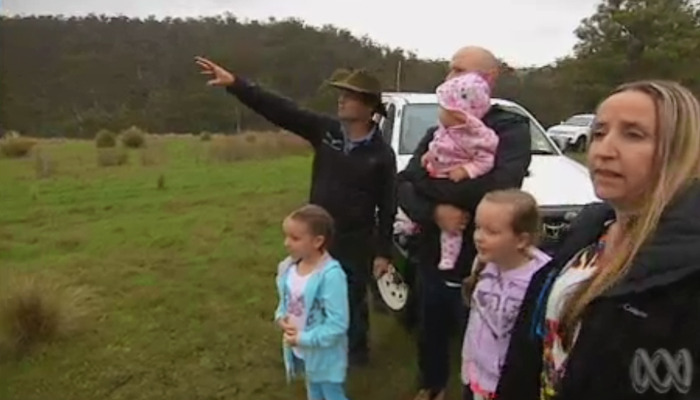
ABC Tasmania's 7:30 Report featured the Tasmanian Land Conservancy’s Revolving Fund on Friday 15 November 2013. We hope many of you had a chance to catch it, even if just to see our Conservation Programmes Officer, Jim Mulcahy, engage in a little slapstick on the property!
Through our revolving fund, we purchase important private properties that represent environmentally significant land in Tasmania; we then on-sell them to caring new owners who become the custodians of the property's natural values.
The news segment covers Chris Palmer and Jane Whitehead's visit from Melbourne to look at the conservation lifestyle block they recently purchased through our revolving fund near Little Swanport.
So if you missed it, you can view the clip here - ABC Tasmania - Taking custody of a slice of Tasmania's wilderness
Donation that launched the TLC named one of Australia's top 50
Posted by on October 14, 2013
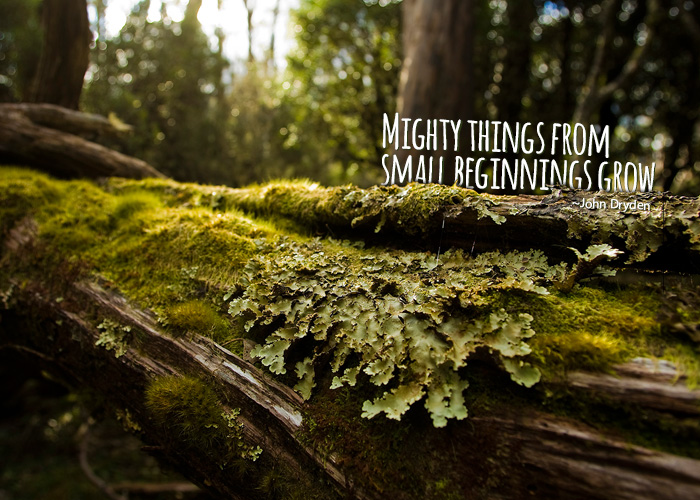
In 2001 three mates chipped in $50 each to create the Tasmanian Land Conservancy and kick-start a vision aimed at protecting Tasmania’s special places. This story of our humble beginnings is one we’re really fond of–biased though we are–because it’s such a testament to what can be achieved purely by ‘giving it a go’.
These mates were our co-founders Nathan Males, Jim Mulcahy and Greg Blake and they were celebrated today at an event in Melbourne to honour Australia’s Top 50 Philanthropic Gifts.
The significance of the $50 that they each pooled over coffee at Hobart’s Retro Café to kick-start the organisation was recognised over donations of substantially higher amounts. Jim said that the donation covered the $101 fee to register the organisation and that the remaining $49 was used to open a bank account.
“With that, the TLC was born. It was a small, slow and steady start but I think it’s a great testament to grassroots organisations who, instead of sitting around and waiting for others to do something, they think: 'Why not have a go ourselves?’" he said.
The story demonstrates the power of a small gift combined with a strong vision to realise a big idea; nurtured in no small part along the way by an army of extremely passionate supporters and a skilled team.
Our CEO Jane Hutchinson said it’s a thrill that Nathan, Jim and Greg’s contribution has been recognised at this very special event.
“The saying is ‘from little things, big things grow’ and the start of the TLC is such a fabulous example of just that,” she said.
Celebrating Australia’s ‘Top 50 Philanthropic Gifts’ was the brain child of the Myer Family Company, The Myer Foundation and Sidney Myer Fund, Pro Bono Australia, Philanthropy Australia and the Asia-Pacific Centre for Social Investment and Philanthropy at Swinburne University of Technology.
It is one way to recognise the incredible impact that philanthropy can have in our society and to inspire more people to contribute to shaping our culture, society and public policy. A great gift is not just about a large sum of money. It can be a vision that understands what can be achieved by taking small steps and encouraging others to follow.
The public is invited to vote for their top 10 favourite stories online and we're hoping that you all like us enough to jump on their website and put in a good word for us! Find out more, along with our ‘origin story’, here - http://bit.ly/19m8O7H
UTAS student investigates sustainable firewood harvest for TLC
Posted by on October 1, 2013

Aerial view of the TLC's Serpentine property.
We’ve been fortunate and are very grateful to our volunteers who give so much of their time to champion biodiversity in Tasmania. Each person comes to us via different routes: maybe a shared conversation at an event, a recommendation by a friend or via our website.
One such volunteer, UTAS student Dana Elphinstone, came to us after hearing a joint ‘Paper Bag Lunchtime Talk’ session at DPIPWE by TLC’s Landscape Ecologist, Daniel Sprod, and University of Tasmania’s Chair of Resource Economics, Professor John Tisdell. The talk, exploring the potential for developing an ecosystem services framework for Tasmania, inspired Dana to seek professional work placement at the TLC.
Dana is completing her Master’s Degree and Graduate Diploma of Environmental Management and Planning. Her work at the TLC explored the potential for a sustainable firewood enterprise on our Bronte properties. These properties already deliver the ecosystem services of carbon sequestration - carbon credits created for sale on the international market, and biodiversity - protecting and enhancing the natural values of land. Both of these services are backed by legally binding agreements and constrain the activities that are possible.
Daniel, who mentored Dana during her time with us, said that Dana’s work had been pivotal in defining both the constraints under which a sustainable firewood enterprise may work, and the nature and scale of benefits.
“She has explored in detail what sustainability means for firewood harvest may mean on our properties,” he said.
“The scoping and policy document she produced brings us a step closer to realising further potential of the properties, which we are actively moving into the new economy.
“As many conservationists have concerns about the impact of firewood harvest on natural values, this is an important piece of work from which we will be able to learn and share with the broader community.”
Dana is one of several science volunteers undertaking important work for us and her time volunteering will be credited to her studies as part of the Professional Work Placement program at UTAS.
If you’re interested in volunteering with the TLC or would like more information feel free to contact our Community Engagement Officer Phillip Roach at [email protected]
Gordonvale is protected!
Posted by on September 2, 2013
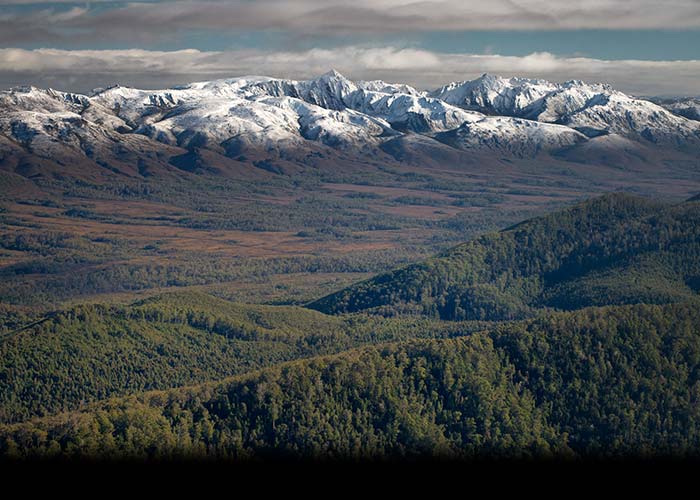
An aerial view of the wild and remote location of Gordonvale with the snow-capped mountains of the Denison Range nestled in the background - by Matthew Newton
By Jane Hutchinson | CEO of TLC
I’m sure that many of you are keen to hear how our efforts to secure the wild and remote property of Gordonvale are going. I am absolutely delighted to let you know that thanks to the generous help of many supporters, together we have been able to acquire Gordonvale as the TLC’s 12th permanent reserve. Thank you so much to all who donated!
When the opportunity arose to acquire the 80 ha property, we knew instantly that it fitted strategically into our overall, long-term conservation science goals.
The TLC has long identified Gordonvale as a World Heritage gem. It’s one of only a few private properties included in the Tasmanian Wilderness World Heritage Area (World Heritage Area), and is completely surrounded by the Franklin-Gordon Wild Rivers National Park.Securing Gordonvale for conservation makes a very important contribution to protecting the integrity of the World Heritage Area as a whole. It is flanked by the spectacular vistas of Great Dome and Wylds Craig. The undulating buttongrass plains, riparian vegetation, scrub and forest of Gordonvale are habitat for some of Tasmania’s iconic and fabulous animals. The nationally endangered Tasmanian devil and the threatened ground parrot are but a few.
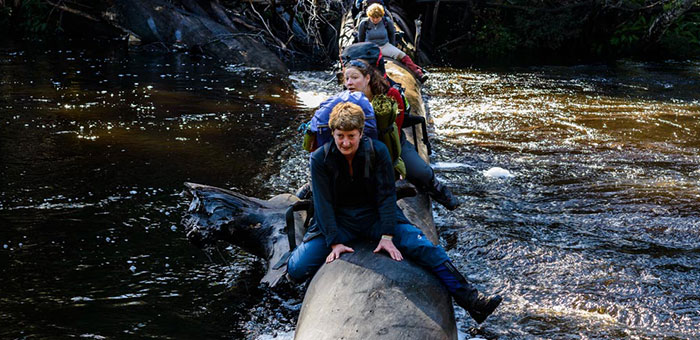
TLC staff Sally Bryant, Denna Kingdom and Marilyn Pauley crossing the Gordon River, illustrating just how hard you have to work to reach Gordonvale - by Grant Dixon
Because of its high altitude, responsible management of the property is critically important in light of the effects of climate change. Responsible management also means working collaboratively with our neighbours to protect the surrounding World Heritage Area.
Our team of conservation scientists will now roll up their research sleeves to develop a Reserve Management Plan for the efficient and effective conservation management of Gordonvale. That means every dollar spent by the TLC is spent wisely on protecting the wonderful plants and animals that live on and around the property.
We have made some very special new connections over the past months with family members of Ernie Bond, bushwalkers and descendants of Gordonvale enthusiasts who have shared their personal memories. Thanks to all who told us a ripping yarn or two about the enigmatic Ernie Bond over a cup of tea or who sent in newspaper clippings, images and stories. Those anecdotes make the journey to protecting Gordonvale so much richer and more joyful and some can be found right here on our website.
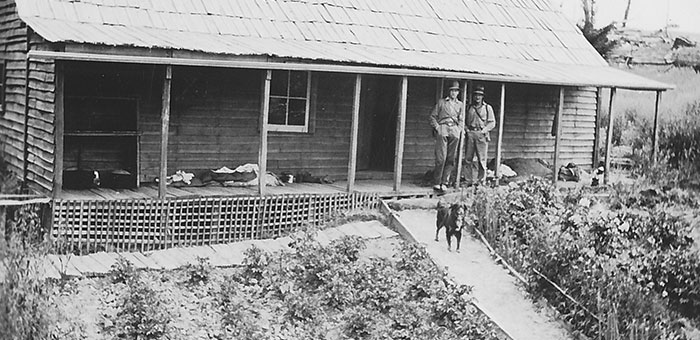
Jim Brough & Leo Luckman on the verandah at Ernie Bond’s property, Gordonvale in the 1930s – by Jack Thwaites
The incredible history of Ernie Bond’s eighteen years at Gordonvale has permeated through people’s accounts and, when setting foot on the property now, it is clear that the site has strong cultural and heritage values. Its unique history qualifies the property for registration in the Tasmanian Historic Archaeological Sites Catalogue. It is the traditional home territory of the Pangerninghe clan of the Big River nation and though the remnants of Ernie’s settlement have largely been reclaimed by vegetation, the foundations and some farm equipment remain.
For many bushwalkers, memories of Gordonvale are of passing through the property en-route to Lake Rhona. Some were lucky enough to have experienced the hospitality of Ernie Bond, including wallaby stew, home-grown vegetables and brew!
TLC now has a network of 12 permanent reserves across Tasmania, protecting globally significant values on ecosystems spanning from estuarine wetlands, coastal woodlands and wet forests to high altitude grasslands and sphagnum peatlands.
Thank you to everyone who has supported TLC to protect Gordonvale as part of this important network of private land reserves forever.
TLC reserves get a helping hand from overseas
Posted by on August 28, 2013

Our ISV team at Flat Rock Reserve - Front (L-R): Jerry (Canada), Mica (Canada) - Rear: Peter (USA), Culea (USA), Alex (USA), Marcy (USA) Stephanie (NZ-ISV Leader) and Laure (USA)
Every year for the past eight years the Tasmanian Land Conservancy has been lucky to partner with International Student Volunteers (ISV) to carry out essential, and sometimes very dirty, work on our permanent reserves.
This year throughout June and July our reserve management staff hosted two fabulous groups of university students from across the US and Canada, who tackled a range of land management activities on our Long Point, Flat Rock and Lutregala Marsh Reserves.
Our Reserves Officer, Tim Devereux, said that the students faced the hard work with smiles and good humour, all whilst braving a Tassie winter.
“They did a great job helping us where we most needed it. It’s not glamorous work, but it’s absolutely worthwhile. We followed up with our weed control plan at Long Point by tackling gorse control, and the 40 cubic metres of old rubbish we removed from Flat Rock was a proverbial weight lifted from the reserve,” he said.
“The program is obviously valuable to us in helping preserve these important ecosystems, but it’s also a really authentic way to introduce people from overseas to Tasmania and its unique people and places.”
Each group worked for two weeks over June and July, with groups visiting a mix of two of the three TLC reserves. But it wasn’t all work and no play, as they had a weekend each to get out into Hobart to experience Dark MoFo, the Festival of Voices and a range of activities the city was hosting at the time.
Alaskan native, Culea Abraham, was one of the enthusiastic student volunteers who participated in the June team at Flack Rock and Long Point Reserve, and she said the fulfilment they felt in a job well done was a great feeling.
“It was a lot of work. But when we looked back and saw a difference, the difference that we were making, we felt a sense of accomplishment; a sense that every little bit counts and we have the ability to change the world,” she said.
“Through the big area of cleared gorse and the loads of rubbish brought to the tip, we are on our way to having a better place to live.”
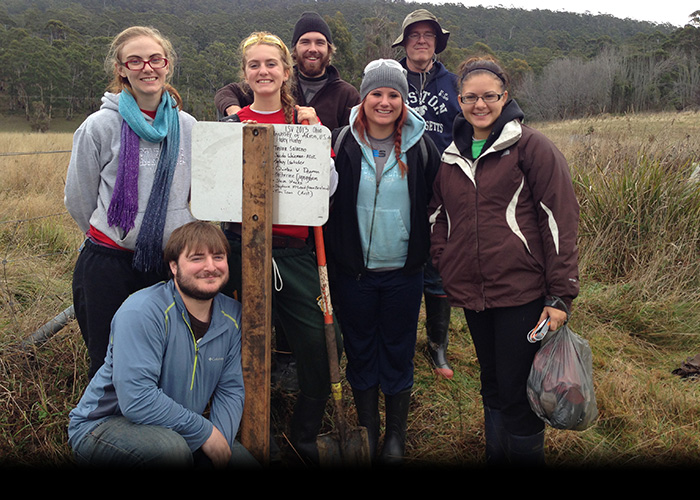
Akron University students at Lutregala Marsh - Front (L-R): Jacob. Middle: Kate, Sydney, Haley, Taylor. Back: Quinten, Dr Weeks.
One of the teams, hailing from Akron University in Iowa, USA, was joined by their professor Dr Stephen Weeks. Dr Weeks specialises in Evolutionary Invertebrate Ecology, and provided the opportunity for the science-based students to receive academic credit for their work on the reserves.
One of his students, Jacob Weizman-Alick, said that Tasmania’s parks, reserves and scenery were some of the most remarkable in the world, and that his time here had been an eye-opening experience.
“Coming from the United States, I found my jaw dropping around every corner as the mountains rise and sink on the horizon. As a part of the ISV I have had the privilege of helping several of Tasmania’s protected reserves by process of removing invasive plant species. Like warriors, we rode forth into battle each day against invaders like gorse, blackberry, Spanish heath and thistles,” he said.
“Experiencing the day-to-day of TLC employees and their struggle to maintain protected land reserves has left me with a resounding respect for the conservation community. I have seen a world I am not soon to forget. Most importantly, I have learned to never take this world for granted, because there is beauty unfathomable if you look for it.”
ISV is a world-wide not-for-profit organisation that gives university students the opportunity to volunteer on projects that enrich sustainable communities. They have been conducting their travel programs for almost 30 years for tens of thousands of students across six continents. These programs combine volunteering, education and adventure travel to create a fun rewarding experience.
Reserves granted highest environmental protection the world can bestow
Posted by on August 6, 2013
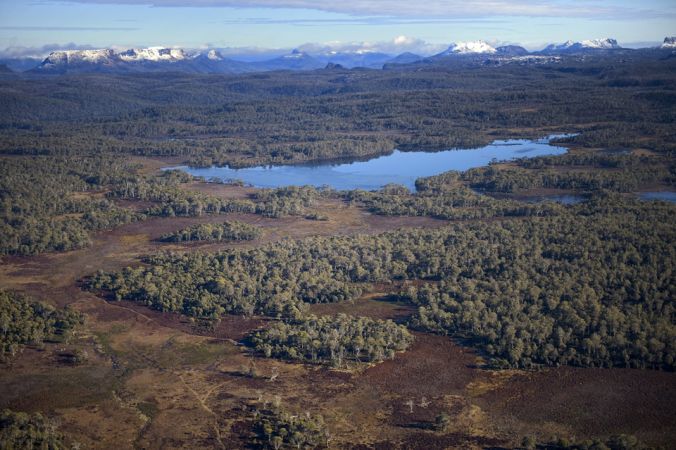
The Tasmanian Land Conservancy is very pleased to share the news that our Skullbone Plains Reserve in the Central Highlands, and our Liffey Reserve in the Great Western Tiers, were formally added to the Tasmanian Wilderness World Heritage Area at the 37th session of the World Heritage Committee in June 2013.
The Australian Government have now formally enshrined that status in the Environment Protection and Biodiversity Conservation Act 1999 (Cth). So, it’s official!
This ground breaking addition of private land to the “World Heritage Area” register means Skullbone Plains (pictured above) and Liffey have been formally recognised for their globally significant values for nature conservation.
To find out more about our Skullbone Plains and Liffey reserves, visit our permanent reserves page
New conservation model to protect biodiversity on farms in the Tasmanian Midlands
Posted by on June 4, 2013
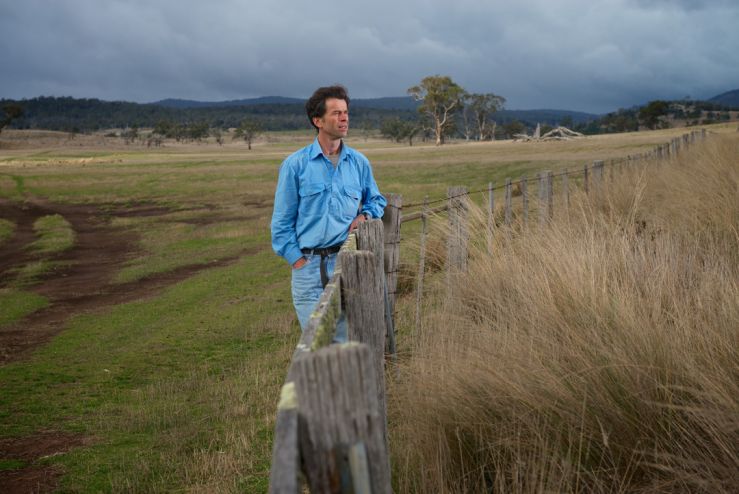
Ross farmer and MCF participant Julian von Bibra at his property, 'Beaufront' - photo by Matt Newton, courtesy Bush Heritage Australia
95% of the Tasmanian Midlands is privately owned, making a new approach to conservation vital for protecting an Australian biodiversity hotspot
Tasmanian Midlands is home to 32 nationally threatened species and more than 180 plants and animals threatened at State level
A landmark $3.3 million conservation fund that aims to conserve biodiversity on farms in the Tasmanian Midlands will be launched on 4 June at ‘Beaufront’ in Ross; one of ten properties that is now signed up to the fund. The fund offers farmers new stewardship agreements to pay for long-term conservation management on their land in a region that is one of Australia’s 15 biodiversity hotspots.
The fund is a partnership between Bush Heritage Australia and the Tasmanian Land Conservancy and will help farmers safeguard the last pieces of remnant native grasslands and grassy woodlands without the need to acquire land.
Work has begun with ten Midlands landowners situated between Epping Forest and Tunbridge in the Northern Midlands. The fund will have the capacity to support many more landowners to conserve habitat on working farms as it works towards the $10 million capital target by 2020.
Landowners who take up stewardship agreements are paid an annual fee for putting an agreed portion of their land under conservation management for a minimum period of 10 years. The stewardship agreements then make annual performance payments for meeting conservation targets, with the goal to roll over for five-year terms.
“What makes this new stewardship agreement model more viable for farmers than traditional conservation covenants is that it is underpinned by a fund that can provide money for conservation in perpetuity,” says Andy Myer, MCF Chairman and Bush Heritage Australia vice-president.
The landowners also receive conservation management resources, including ecological monitoring support to ensure the farm-based conservation programs are well supported.
“The Midlands is an important working landscape which needed a fund that works for landowners. In order to protect the last pieces of remnant native grasslands and grassy woodlands left in this important biodiversity hotspot, lasting conservation outcomes need to be balanced alongside livelihoods, and the MCF delivers on both fronts,” says Jane Hutchinson, Tasmanian Land Conservancy CEO.
Landowner Julian von Bibra, who is conserving 190 hectares of endangered grasslands on his farm in the Northern Midlands under the fund, says: “The MCF means that we now have a model that is committed to conservation and farmers working together for shared goals. Essentially, conservation now has a place on the balance sheet.”
The MCF is part of a broader ‘Midlandscapes’ project which has a goal of ensuring ten per cent (or 64, 000 hectares) of the Tasmanian Midlands Biodiversity Hotspot is conserved by 2020.Native species protection priorities include vulnerable marsupials such as the Tasmanian bettong (a species extinct on the mainland) and spotted-tailed quoll; wedge-tailed eagles; critically endangered lowland grasslands; and nationally threatened plants such as the tunbridge buttercup and pungent leek-orchid.
Remove gorse with force… of course, of course
Posted by on May 27, 2013
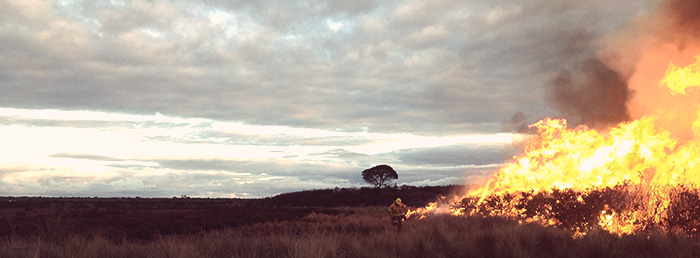
Last week the TLC’s first permanent reserve, Long Point, had segments of it set ablaze as part of our extensive weed control efforts, which incorporates planned burns as just one method of control in our overall approach.
TLC staff and contractors burnt 15 hectares of gorse, an incredibly invasive and robust weed, in an attempt to control its spread. Gorse is listed as a problematic plant species on the Weeds of National Significance (WoNS) list by the federal government, with the list ranking weeds based on invasiveness, impacts, potential for spread, and socioeconomic and environmental values. Inclusion on this list means that it is critical to control its impact, especially in Tasmania where it is most rampant.

Planned burning at Long Point Reserve
Our Reserves Manager, Denna Kingdom, coordinated the burn and said that fire, as a property management tool, has been used by farmers to control gorse for decades but that it doesn’t actually kill adult plants.
“We’ll be back here next summer and autumn to control any mature plants that re-sprout and kill any seedlings that come up.
“Fire germinates the seeds that lie dormant in the soil and so, if follow up treatment isn’t undertaken, the weed problem becomes much, much worse,” she said.
This burn will allow our staff, volunteers and contractors to get into areas that were previously impenetrable due to the volume of gorse, whilst simultaneously stimulating the gorse seed bank, which will be treated next year.
In addition, we’re undertaking scientific monitoring in both burnt and unburnt areas of gorse to determine the effectiveness of fire in long-term gorse control programs. Results of this research will be shared with the community to ensure that others can make informed decisions when applying their weed management approach.
TLC has been very fortunate to secure grant funding from the Tasmanian Landcare Association’s Biodiversity Grants recently, which will assist in funding weed control at Long Point until 2015. Glamorgan-Spring Bay Council and NRM South also provided grant funding to assist with the development of a fire management plan for Long Point Reserve.
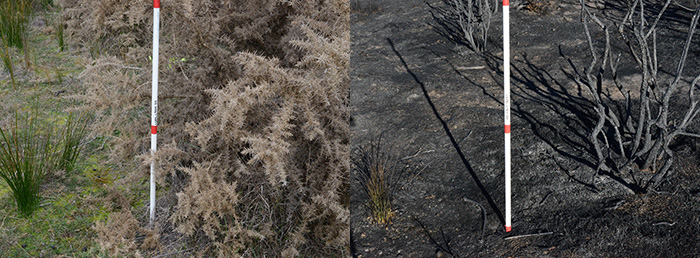
A 'before & after' shot which will form part of our monitoring program.
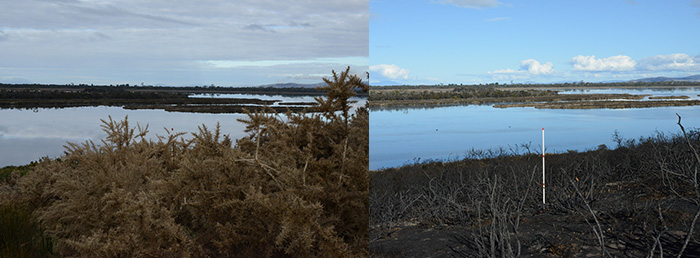
Could this be our youngest supporter?
Posted by on March 21, 2013
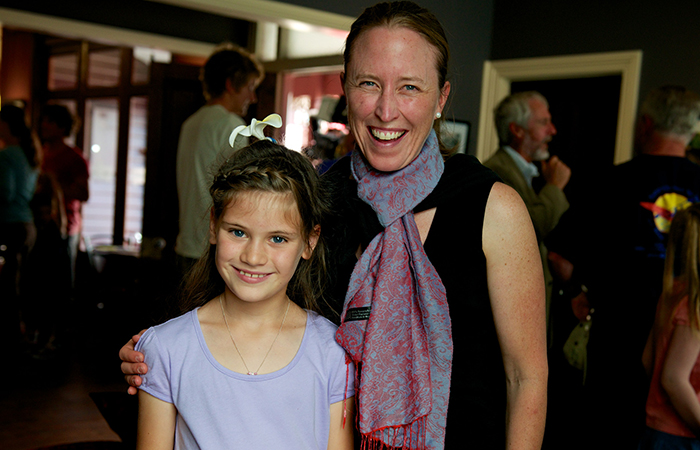
Young TLC supporter Laura Ashby and TLC CEO Jane Hutchinson at Laura's exhibition in Sheffield.
Quite possibly our youngest supporter, young photographer Laura Ashby, won our hearts over with her generosity and impressed us with her raw talent. The eight year old, who has a gift for nature photography, held her first exhibition at Gallery Tasmania in Sheffield last month with all proceeds donated to the TLC.
Our CEO Jane Hutchinson was there on the day to thank Laura for her thoughtfulness and support, as well as to nab a gorgeous framed shot of a spotted quoll.
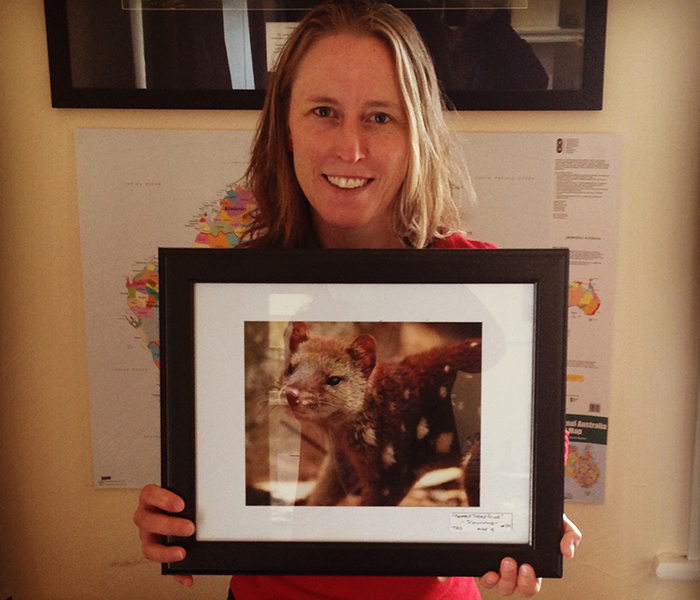
Jane Hutchinson with the framed photograph of a spotted quoll from Laura Ashby's collection.
“It’s amazing that someone so young not only has such a beautiful gift and eye for photography, but has a generous heart to go with it. I just assumed eight year olds were more concerned with One Direction than protecting land for conservation, but I’ve never been happier to be proven wrong,” she said.
“The proceeds from Laura’s exhibition will go towards helping us acquire and care for an iconic property in Tasmania’s southwest called Gordonvale, which is much-loved by the state’s bushwalking community because of its history and stunning natural values.
“Laura’s name, along with other supporters who donated $300 or more to the Gordonvale campaign, will be commemorated on a plaque at the site next to interpretation signage we hope to build once we secure the property.”
Laura will also be attending the TLC’s next nature event at the Blue Tier on Saturday 27 April 2013 on a walk that’s perfect for budding nature photographers. To register and find out more about the event, visit bluetier2013.eventbrite.com
To see a selection of Laura's work visit www.redbubble.com/people/pepperpotpics
Stag beetles found on TLC properties
Posted by on February 26, 2013
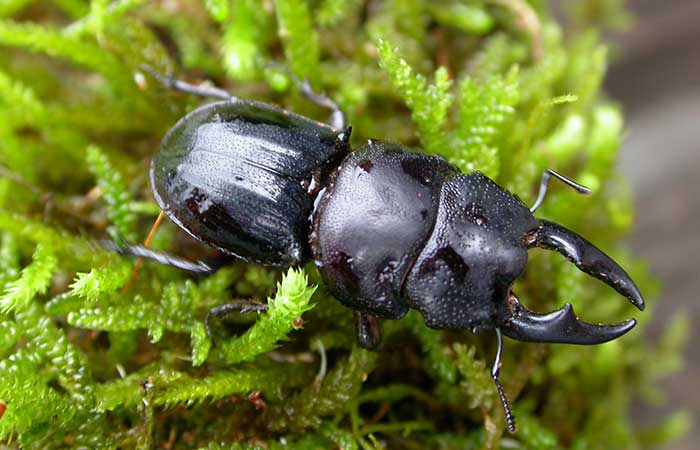
Close-up of a Simson's stag beetle
Over the weekend TLC volunteer and ecologist Jane Keble-Williams lead workshops at Blue Tier reserve and one of our revolving fund properties, West Pyengana, to look for stag beetles as part of her intensive ecological survey work for us.
The trip was a resounding success with the team confirming the presence of the iconic Simson’s stag beetle at Blue Tier and the equally vulnerable Vanderschoor’s stag beetle at West Pyengana.
Our Conservation Scientist Matt Taylor helped Jane organise and design the project and he attended the workshop with his mum and dad, Richard Taylor and Lillian Haines, who own a small farm at Goshen, which is in the same catchment as the Blue Tier and West Pyengana.
"The workshop was organised specifically with local landowners in mind, which is why mum and dad attended," he said.
"They were there to help with the survey work, but also got to learn about survey techniques that they can then apply to their own property, which is home to the threatened giant velvet worm (Tasmanipatus barretti).
"By engaging locals in the northeast in activities like this one we have the benefit of accessing local knowledge, have some extra hands, ears and eyes for the research activity and all whilst raising community awareness of invertebrate conservation.
"The Blue Tier and surrounds is a real hotspot for threatened and endemic beetles, velvet worms and snails... and other unusual creatures, no doubt!"
The research is titled, A survey of threatened stag beetle species on the Tasmanian Land Conservancy Blue Tier and West Pyengana reserves in North East Tasmania. The data collected will help direct conservation management at the reserve and will also be forwarded to the DPIPWE Threatened Species Section for inclusion in the state government’s Natural Values Atlas.

Jane Keble-Williams painstakingly looking for stag beetles with a volunteer at the Blue Tier - Photo by Matt Taylor
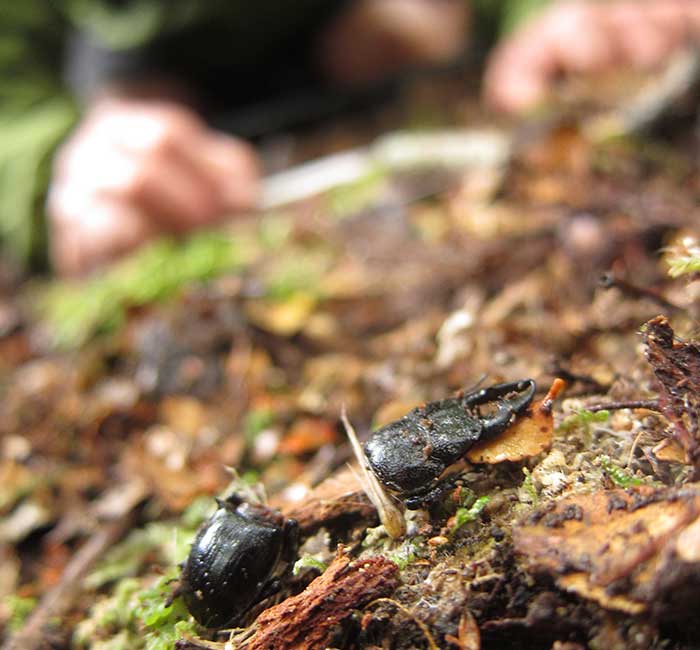
Parts of a Simson's stag beetle found at the Blue Tier - photo by Matt Taylor
Fire research tackled by TLC intern
Posted by on February 11, 2013

For the next few weeks the TLC is hosting Ms Conamara Burke from the University of Montana, who is visiting Tasmania as part of the United States National Science Foundation’s Partnerships for International Research and Education (PIRE) internship program. Conamara is working with TLC Conservation Scientists, Matt Taylor and Sally Bryant, on a project to document the recovery after bushfire of TLC’s Silver Peppermint Reserve.
In January 2013 Silver Peppermint Reserve was burnt by a large bushfire that began at Lake Repulse in the Derwent Valley. The entire property was affected, with the canopy scorched and the understorey vegetation completely incinerated by the fire.
Conamara is investigating how the regeneration of understorey vegetation coincides with the return of bird species to the reserve. The project is using modern techniques – digital photography and digital sound recording – to document the changes that occur in the ecosystem immediately after fire.
Ten fixed photo points were established four days after the bushfire. At each photo point a series of identical photographs are being taken of the understorey vegetation at weekly intervals for the next eight weeks. The series of photos will provide a visual record of the regeneration process. The photos will also allow quantitative ecological data on vegetation structure to be recorded.
Sound recorders are being used to document the bird species that return to Silver Peppermint over the eight week period. The recorders are placed at three of the photo points and record 20 minutes of bird song. An expert ornithologist is then able to identify the species of birds that are present at the property from the recordings.
By documenting the vegetation structure and bird species present at the reserve each week, the project aims to better understand the ecological relationship between bird diversity and vegetation structure in the period immediately following fire. The project will also produce a fascinating audio-visual record of the regeneration of Silver Peppermint Reserve.

